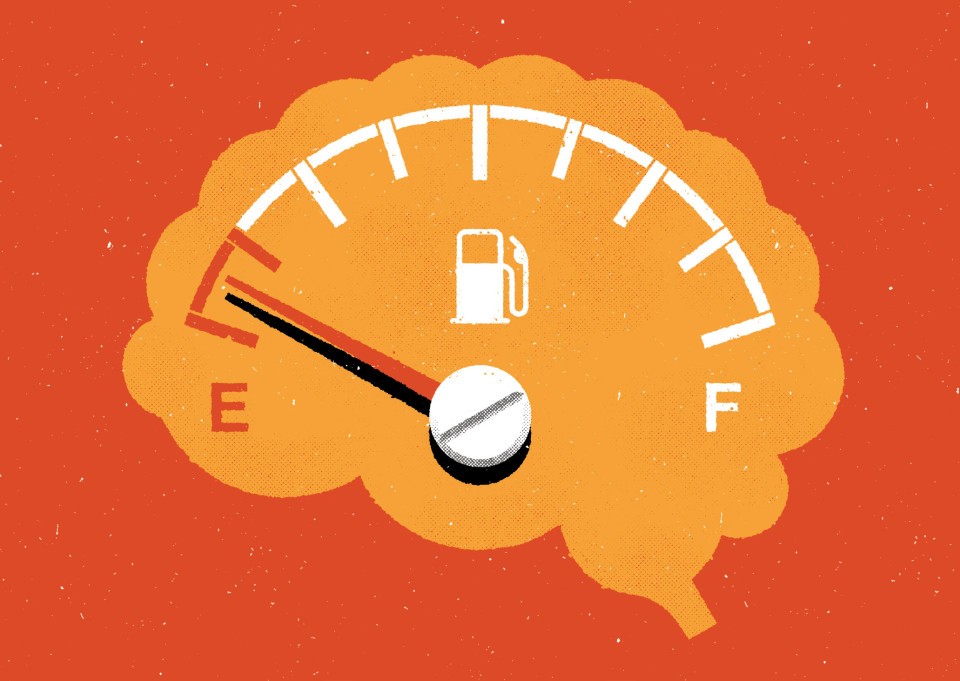How America’s Adderall Shortage Reflects a Long-Broken System
A shortage of drugs to treat ADHD has turned tracking medication down into a full-time job.

The nationwide Adderall shortage has been draining. / Illustration by Matt Harrison Clough
I’m walking through Rittenhouse on the way to get my daughter from school on Valentine’s Day, and I get a text from my husband, Matt. He’s leaving work early to pick something up for me. It’s going to be expensive, but it’s not unusual to have to pay a premium for something that’s hard to get, especially given the timing. I’m filled with gratitude. Flowers? Chocolates? Some sparkly jewelry? Nope: amphetamines.
Specifically, Adderall — the brand-name version. Our insurance only covers generic, which isn’t available anywhere at the moment, so it’ll cost $250 — which could buy a very nice V-Day gift, mind you. It’s a price we’re willing to pay so I don’t become a zombie who can’t do her job, much less get out of bed. Withdrawal isn’t worth it.
I know, because over the past six months, I’ve experienced intermittent days of withdrawal, despite my best attempts at planning ahead to avoid it — despite Matt and me calling dozens of pharmacies increasingly farther from Center City as my pills for the month dwindle. (With federal restrictions on Adderall, we can’t begin our search too many days in advance, because I wouldn’t be allowed to refill then anyway.) We’ve memorized the automated menus by now and hit the correct keypad choices before the robot operator can give us the rundown. One month, we found some in Bala. This month, it was a small independent pharmacy in Northern Liberties. We got lucky.
In October of 2022, the Food and Drug Administration announced a nationwide shortage of Adderall, a.k.a. mixed amphetamine salts, a drug commonly used to treat attention deficit hyperactivity disorder. The shortage trickled down to other ADHD medications as some users unable to get Adderall switched to more readily available alternatives. The result: Millions of people diagnosed with ADHD have been struggling to find their medicine for months now, and it’s taking a toll on their mental, emotional and financial health. And while some of the supply-side reasons for this crisis show signs of abating, there are larger, systemic issues that highlight how messed up this situation has been for far too long. ADHD drugs aren’t the only ones affected by kinks in the supply chain — recently, Tamiflu, amoxicillin and Children’s Tylenol, among others, have been scarce. But Adderall serves to illustrate the wider problems in the industry.
When I was growing up, in the ’90s, ADHD made me a “bad kid” — I was bored, I talked in class, I was “emotional” and “impulsive.” But like many others with the disorder, I was also identified as gifted, so while I spent many recesses standing against the wall — a truly misguided form of discipline for a hyperactive kid — I was lucky enough not to suffer academically. It wasn’t until I started taking medication, in college, that I began to fully understand I’d been playing on hard mode my whole life. While I thrived at my rigorous liberal arts college, I was met with a new form of scrutiny and suspicion — this time, from pharmacists with built-up skepticism toward those asking for the oft-abused drug.
This isn’t uncommon. Due to their addictive nature, their popularity as street drugs, and their likelihood for abuse, Adderall and similar stimulants are classified by the FDA as Schedule II controlled substances. What does this mean in practice? While non-controlled medications can be easily called in with refills — CVS can’t text me soon enough to tell me those are waiting for me at the pharmacy — you have to jump through a series of hoops to get Adderall every month.
For starters, up until a few years ago, you had to have a physical paper prescription every time you needed a refill. (Pennsylvania switched to e-prescription in 2019; it requires that doctors use a very specific electronic health record system that meets federally mandated security requirements, and there’s still no calling in a refill.) And, of course, there’s the added cost built into monthly prescriptions: ongoing visits with a therapist that can run upwards of $200 per session. For those with ADHD, the added cost goes beyond the monetary; keeping track of all those appointments and errands can take a significant mental toll.
And that’s when everything works out.
Now, there’s the added complication that your pharmacy likely doesn’t have any Adderall, so you need to call your doctor to see if your script can be sent elsewhere in hopes that place will have it, or you try to get creative with dosing or get a whole new prescription for a substitute medication. (I had to switch to a lower dose in January because that was all I could find; this also required a new prescription.)
And that’s if the pharmacy will even tell you whether it has the drug in stock. Some places have been reticent to give out this information over the phone — the risk of burglary is one reason — so you have to pound the pavement and hope. Finding illegal drugs would be so much easier than this … thanks to a system designed to combat illegal drugs.
“Half of them won’t even tell me if they have it in stock, and I give my license number on behalf of the patient,” says Center City psychopharmacologist Louis Littman, who estimates he has 125 patients on stimulants.
Littman fields constant messages from patients who can’t get their medication and need him to log into the system to send prescriptions to another pharmacy or prescribe a different stimulant. “Every day for the last nine months, I get multiple texts a day from patients all over, saying ‘This pharmacy’s out; can you send it here?’” This process in itself can cause delays — delays that mean more missed doses, more missed assignments, more falling behind.
To complicate matters, Littman tells me, switching drugs isn’t recommended for all patients, since ADHD drugs aren’t bioequivalent. For example, he says, “Adderall is a mixture of two chemicals. Vyvanse turns into one of those chemicals, but some people need both components for optimal benefit.”
The rigid regulations designed to protect us have only led to more anxiety and loss of productivity. Aside from the frustration this shortage is causing, what scares me is the utter hopelessness of it all.”
As with so many issues, the COVID pandemic is largely to blame for this current drug shortage, on both micro- and macro-economic levels. First, the pandemic shut down China, where many of the precursor chemicals for stimulants are produced. Then, in 2021, Teva Pharmaceuticals, the largest manufacturer of generic Adderall, halted production at its Irvine, California, plant due to contamination issues raised by FDA inspectors and an ongoing labor shortage.
Meanwhile, demand for Adderall and other ADHD medications has only gone up. Analytics firm IQVIA shows a recent 27 percent increase in prescriptions, from 35.5 million in 2019 to 45 million in 2022. Reasons for this are also pandemic-related. Many people with ADHD who didn’t need medication before the pandemic found they couldn’t focus as well when working from home, since structure and routine are important coping mechanisms. “It’s not that they suddenly developed ADHD; it’s that they were operating at a level that wasn’t impairing them, but then it was,” Littman explains. Another pandemic-related reason for the spike in demand: Stimulants like Adderall are prescribed as off-label treatments for long-COVID brain fog.
(Not all the COVID-related causes for increased demand are entirely negative. Because the pandemic led to an expansion of telehealth, more people were able to access mental health care than ever before — which meant more diagnoses. “People who weren’t treated in the past suddenly could get treatment,” Littman says.)
But wait; there’s more: Each year, the Drug Enforcement Administration sets an annual limit on the quantity of amphetamines that manufacturers can produce. The DEA bases these aggregate production quotas (APQ) on data from previous years — and while it claims that in the past three years, manufacturers didn’t meet those quotas, the unprecedented recent increase in demand meant the DEA’s year-over-year estimate was inadequate. “They’re not taking into account the real-world changes that have occurred with the pandemic,” says Littman. Despite evidence of the Adderall shortage in October 2022, the DEA declined to increase the APQ for 2023. Other medications, from Ozempic to albuterol, are in short supply, too. And while they don’t have the added difficulty of being controlled substances, no health-sustaining prescription should come with such uncertainty.
Robert Field, an expert in health-care regulation and professor at the Kline School of Law and Dornsife School of Public Health at Drexel, says one reason for this crisis that hasn’t been widely discussed is our health-care system’s heavy reliance on generic drugs, whose supply is actually more vulnerable to disruption. “Generic companies have fixed capacity, and they devote it to those drugs that are in demand, at the levels of demand that are prevailing,” Field says. “They can’t just flip a switch and go from drug to drug if there’s a sudden increase in demand. It might involve shortchanging other products they make.” Generic drug companies have much smaller profit margins than their brand-name counterparts, so their financial incentives to continue producing the same drugs aren’t as great, Field notes, and adds, “It would help if we could get a better handle on brand-name drug prices, to reduce the difference with generic prices. The government could also adjust the balance by increasing reimbursement rates for generic drugs under Medicaid.”
Field says the FDA should also supervise suppliers more closely and be more proactive about possible manufacturing woes and disruptions. “It’s not like an electronic gadget, where if there’s not enough supply, you can wait a few months to get your iPhone,” he explains. “This is something people need every day, so I think it’s a legitimate area for the government to be aggressively involved in.”
The cruel irony is that the people affected by the shortage are the very people who, thanks to their ADHD, lack the executive functioning skills needed to solve the monthly scavenger hunt that getting refills has become.
The rigid regulations designed to protect us have only led to more anxiety and loss of productivity. Aside from the utter frustration and waste of time this shortage is causing, what really scares me is the utter hopelessness of it all. I’ve worked so hard for so long to have everything I want, but in my darkest moments, I worry it’s all precarious — that because some factory in California had water damage, I’m going to lose everything someday. Like the spell will be broken, and my carriage will be a pumpkin again. And I know none of that’s true, but being physiologically dependent on something that’s suddenly scarce can bring out the worst thoughts. Like many people with ADHD, I already live in a rigid yet delicate balance — a measured cocktail of routine, structure, self-imposed rules, therapy and medicine. And while I’m blessed to have him, I shouldn’t also need a spouse who will scour Google Maps and call 40 pharmacies for me on Valentine’s Day.
Published as “Attention Must Be Paid” in the May 2023 issue of Philadelphia magazine.


